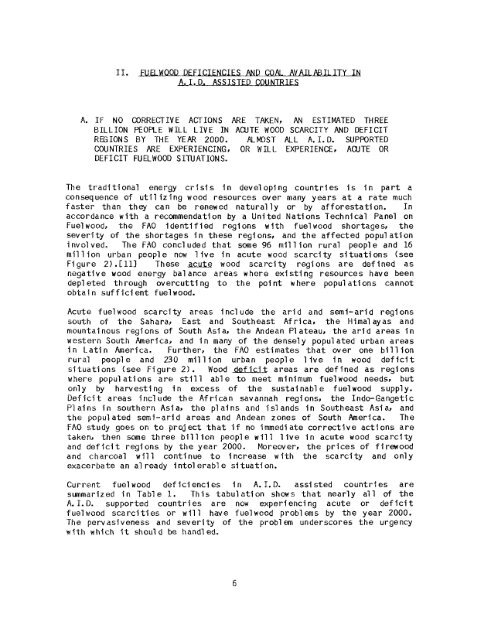Prospects for Coal Briquettes as a Substitute Fuel for Wood and ...
Prospects for Coal Briquettes as a Substitute Fuel for Wood and ...
Prospects for Coal Briquettes as a Substitute Fuel for Wood and ...
Create successful ePaper yourself
Turn your PDF publications into a flip-book with our unique Google optimized e-Paper software.
A. IF NO CORRECTIVE ACTIONS ARE TAKEN, AN ESTIMATED THREE<br />
BILLION PEOPLE WILL LIVE IN ACUTE WOOD SCA CITY AND DEFICIT<br />
REGIONS BY ‘THE YEAR 2000. AL ST ALL A.I.D. SUPFSORTED<br />
COUNTRIES ARE EXPERIENCINGI OR WILL EXPERIENCE, ACUTE OR<br />
REFICIT FUELWOOD SITU ATIQNS.<br />
The traditional energy crisis in developing countries is in part a<br />
consequence of utilizs’ng wood resources over many years at a rate much<br />
f<strong>as</strong>ter than they can be renewed naturally or by af<strong>for</strong>estation. In<br />
accordance with a recommendation by a United Nations Technical Panel on<br />
<strong>Fuel</strong>woo& the FAO identified regions wdth fualw od shortagesP the<br />
severity of the shortages in these regions, <strong>and</strong> the affected population<br />
involved. The FAQ concluded that some 96 mil 1 ion rural people <strong>and</strong> 16<br />
million urban people now live in acute wood scarclty situations (see<br />
Figure 2) .C111 These acxk wood scarcity regions are defined <strong>as</strong><br />
negative woad energy bal ance are<strong>as</strong> where existing resources have been<br />
depl etecl through overeutti ng to the poi nt where popul ations cannot<br />
obtal n suf f Ici ent fuel wood.<br />
Acute fuelwsod scarcity are<strong>as</strong> include the arid <strong>and</strong> semi-arid regions<br />
south of the Saharal E<strong>as</strong>t <strong>and</strong> Southe<strong>as</strong>t Africa, the Himalay<strong>as</strong> <strong>and</strong><br />
mountainous regions of South Asia, the Andean Plateau, the arid are<strong>as</strong> in<br />
western South Americap <strong>and</strong> in many of the densely populated urban are<strong>as</strong><br />
in Latln America. Furtherp the FA0 estimates that over one billion<br />
rural people <strong>and</strong> 230 mlllian urban people 1 ive in wood deficit<br />
situations (see Figure 2). <strong>Wood</strong> deficit are<strong>as</strong> are defined <strong>as</strong> regions<br />
where populations are still able to meet minimu fuel wood needs, but<br />
only by harvesting in excess of the sustadn le fuelwood supply.<br />
Deficit are<strong>as</strong> include the Af rican savannah regions, the Indo-Gangetic<br />
Plains in southern Asiar the plains <strong>and</strong> isl<strong>and</strong>s in Southe<strong>as</strong>t Asia, <strong>and</strong><br />
the populated semi-arid are<strong>as</strong> <strong>and</strong> Andean zones of South herfca. The<br />
FA0 study goes on to project that -if no Immediate correctlve actlons are<br />
taken3 then sane three billion people w i l l live in acute wood scarcity<br />
<strong>and</strong> deficit regions by the year 2000. Mor err the prices of firewood<br />
<strong>and</strong> charcoal w i l l continue to incre<strong>as</strong>e h the scarcity <strong>and</strong> only<br />
exacerbate an a1 ready i ntol erabl e situation.<br />
Current fuel wood d@f ici enci OS in A. I. D. <strong>as</strong>si sted countries are<br />
summarized in Table h. This tabulation shows that nearly all of the<br />
A. I. D. supported countries are now experiencing acute or deficit<br />
fuelwood scarcities or w i l l have fuelwood problems by the year 2000.<br />
The perv<strong>as</strong>iveness <strong>and</strong> severity of the probl underscores the urgency<br />
w1t.h which it should be h<strong>and</strong>led.<br />
6

















